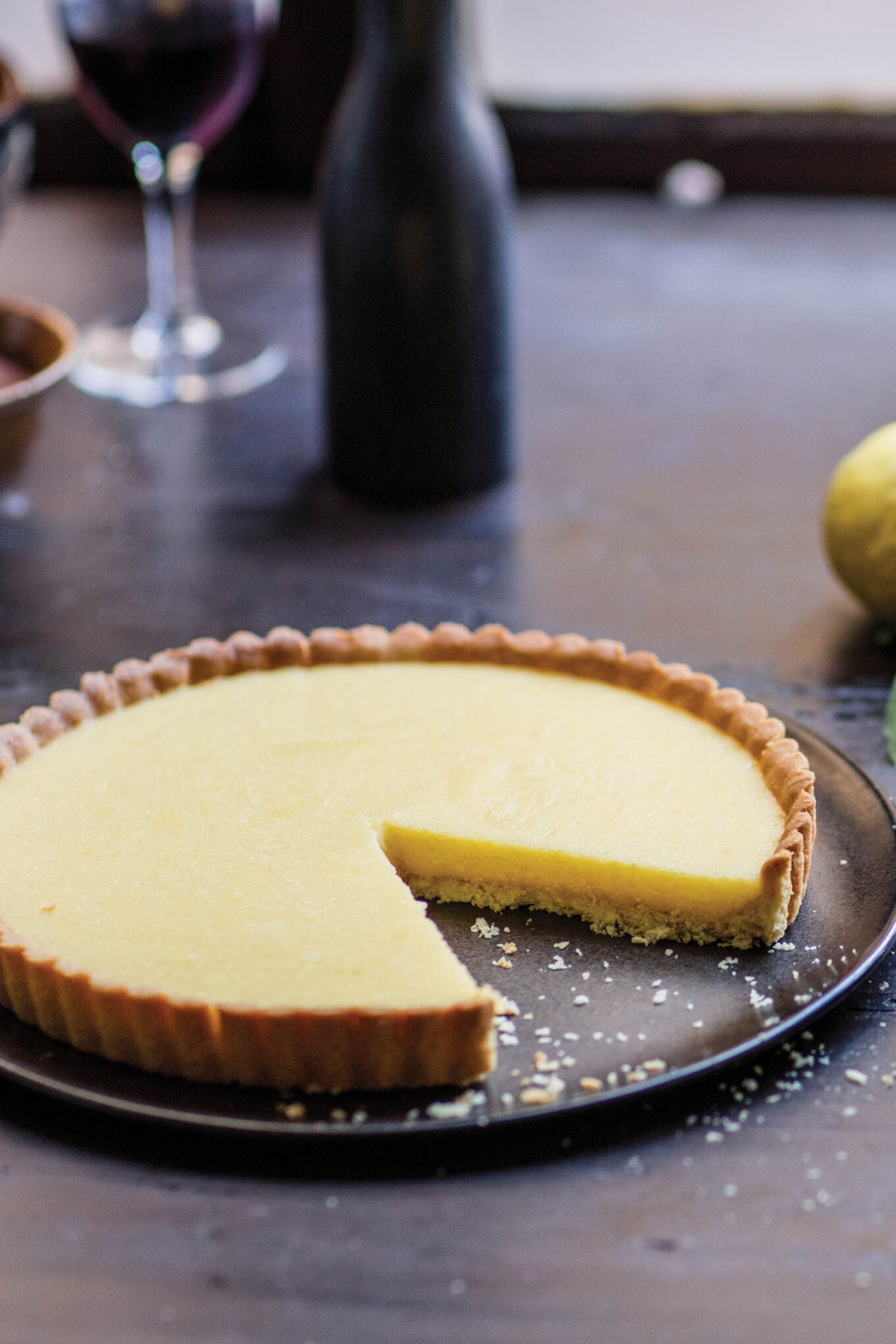
Words by Rosa Jackson. Photos by Jan Hendrik van der Westhuizen.
I first came across a version of this recipe in French Elle magazine and, intrigued by the presence of olive oil in both the pastry and the filling, tweaked the tart until it became my own. Niçoise olive oil is ideally suited to desserts because of its buttery, almond-like quality, but you can use any mild-tasting, fruity olive oil.
If you are a pastry novice, this is an ideal dough to start with because you can treat it like Play-Doh, pressing it into the pan with your fingers and patching any holes. Unlike pure butter pastry, it needs no resting time, and it shrinks very little in the oven. The olive oil gives it a light, crumbly texture, like shortbread. I learned the trick of whisking lemon curd until fluffy while taking a macarons class in Paris, and here the airy filling makes a perfect match for the delicate crust.
My son has eaten this lemon tart countless times, yet this is the dessert that he still asks for on his birthday and whenever he comes home from college. You can bake the pastry shell several hours ahead of time; once assembled, the tart is best eaten the same day.
Order your copy of Niçoise: Market-Inspired Cooking from France’s Sunniest City by Rosa Jackson and savor the flavors of the French Riviera.
Tarte au citron à l’huile d’olive
Ingredients
- 4 tablespoons (60 g) unsalted butter, at room temperature
- ¼ cup (30 g) confectioners’ sugar
- 1½ tablespoons almond meal
- ¼ teaspoon fine sea salt
- 1 cup (120 g) all-purpose flour
- 1 large egg yolk
- 3½ tablespoons delicate-tasting extra-virgin olive oil
- ¾ cup (150 g) sugar
- 2 teaspoons cornstarch
- 1 tablespoon grated lemon zest, preferably from an organic lemon
- 2 large eggs
- 2 large egg yolks
- ¾ cup (180 ml) freshly squeezed lemon juice (from 3 to 4 lemons)
- 4 tablespoons (60 g) unsalted butter
- 2 tablespoons delicate-tasting extra-virgin olive oil
Instructions
- Preheat the oven to 375°F (190°C).
- In a mixing bowl, combine the butter, confectioners’ sugar, almond meal, salt, and 2 tablespoons of the flour and blend until creamy with a pastry scraper or a fork. Add the egg yolk, olive oil, and the remaining flour. Mix again with the scraper or fork until the dough forms a smooth ball. (You can also make the dough in a food processor or a stand mixer fitted with the paddle attachment, starting with cold butter so that the mixture doesn’t become too soft to work with.)
- With your fingers, press the dough as evenly as possible into the bottom and up the sides of a 9-inch (23 cm) tart pan, preferably with a removable base. (It’s normal for the dough to be very soft at this point, but if it’s too sticky to work with, flatten it with your hands to about ½ inch/1 cm thick in the tart pan and refrigerate for 15 to 20 minutes before proceeding.) Press the dough against the sides of the pan so that it extends at least ½ inch (1 cm) above the rim, then cut off the excess with one swipe of a rolling pin across the top. Press the pastry lightly with your thumb all around the sides so that it comes slightly above the rim, to compensate for any shrinkage as it bakes.
- Place the tart pan on a baking sheet and bake for 12 to 14 minutes, until the pastry is golden brown all over, turning the pan after 8 minutes if it seems to be browning more on one side. Remove the tart pan from the oven and set it on a rack to cool completely.
- Place the sugar and cornstarch in a mixing bowl. Rub the lemon zest into the sugar with your fingertips to extract its essential oils.
- Add the eggs and egg yolks and whisk until well combined. Gently whisk in the lemon juice.
- Transfer the mixture to a heavy saucepan and cook over medium-low heat, whisking vigorously in a side-to-side motion to lighten the mixture and prevent lumps from forming. After about 5 minutes, the curd should start to thicken like pudding and the foam on the surface will start to disappear. Let the curd come just to a boil (you should see a few big bubbles when you stop whisking), then turn off the heat.
- Add the butter in pieces, whisking until melted. Add the olive oil and whisk until completely incorporated.
- Using a heatproof spatula, scrape the hot filling into the cooled crust, working quickly, as the filling will begin to set almost immediately. Place in the refrigerator to set for at least an hour. (If you are in a hurry, you can pour the filling into a still-hot crust, but you will need to allow more time for the tart to set.)
- If your pan has a removable bottom, place it on a small bowl so that the rim falls down, and transfer the tart (on its metal base) to a plate. Otherwise, serve the tart from the pan without attempting to remove it, as the crust is very fragile.
Niçoise: Market-Inspired Cooking from France’s Sunniest City by Rosa Jackson, photos by Jan Hendrik van der Westhuizen (W. W. Norton & Company, 2024).